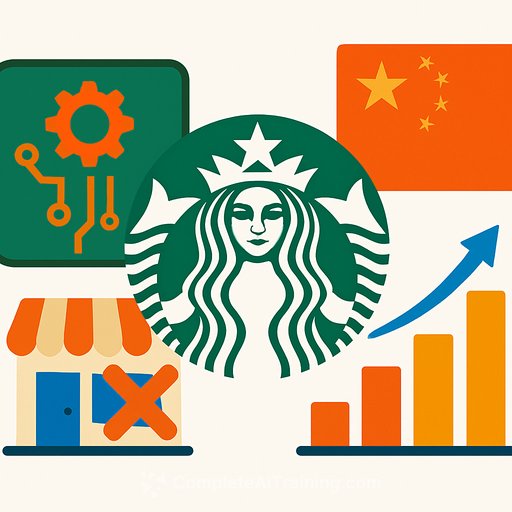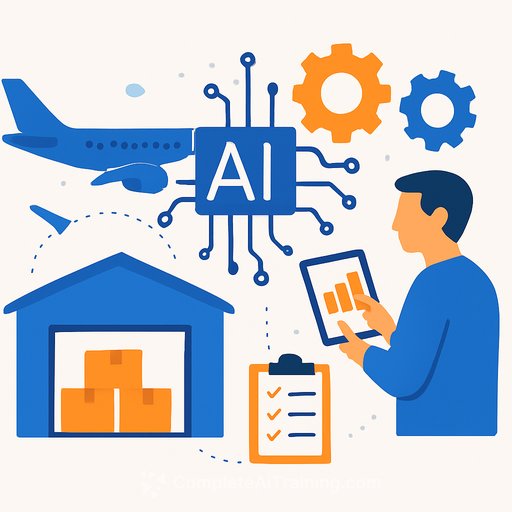Can Starbucks' AI-Powered Overhaul Reignite Its Global Growth Ambitions?
Starbucks is moving fast under CEO Brian Niccol. The plan: roll out AI-powered in-store tools, refresh the menu, restructure operations with targeted store closures and workforce changes, and consider a partial sale of its China business. For operators, this isn't about headlines. It's about throughput, cost per transaction, and consistency at scale.
The operations thesis in plain terms
The core bet is simple. Better in-store execution and smarter personalization drive transaction growth and help margins recover. The near-term reality is harder: U.S. same-store sales still need a reset, and labor and operating costs remain stubborn.
AI enters the picture to improve order speed, accuracy, and the guest experience without adding immediate headcount. Whether those efficiency gains outpace wage and input inflation is the key question.
What Starbucks is rolling out
- AI-powered tools, including a virtual barista assistant, to streamline tasking, speed up ordering, and personalize recommendations.
- Menu innovations that can shift mix and average check, while testing prep complexity and station design.
- Restructuring of the store base and workforce to align formats and staffing with demand patterns.
- Exploration of a partial sale of the China business, with interest from multiple equity firms, signaling a rebalanced international focus.
How AI in-store tools could move the P&L
- Throughput: Faster order sequencing and fewer remakes reduce bottlenecks during peak windows.
- Labor productivity: Smarter task allocation and forecasting protect minutes per transaction without sacrificing service.
- Waste and prep: Better demand signals tighten inventory and batch sizing for brewed and food items.
- Mix and check: Personalized suggestions can lift attach rates for food and cold beverages if done with restraint.
Risk: efficiency wins may be offset by wage growth and training needs. The system must prove durable across formats, dayparts, and staffing levels.
Network and market mix implications
Store closures and workforce changes suggest a push toward formats with cleaner unit economics. The potential China stake sale reduces exposure and frees capital, but it also lowers direct control in a market that has been strategic. Operators should expect tighter capital allocation and higher bar for new units and remodels.
What success must look like by 2028
- Revenue target: about $45.5 billion.
- Earnings target: about $4.6 billion, up from roughly $2.6 billion today.
- Implied revenue growth: about 7.5% per year.
Some models point to a fair value near $97.63 per share, about 14% above recent pricing. Community estimates vary widely (roughly $51 to $110), reflecting uncertainty over how persistent margin pressure will be.
Operator's 90-day playbook
- Define success metrics: peak wait time, order accuracy, remakes per 1,000 orders, labor minutes per transaction, product waste, and attach rates.
- Pilot with intent: pick stores with different volumes and footprints; run A/B scheduling and station layouts.
- Integrate with POS and forecasting: ensure clean data flows and clear fallback procedures if AI recommendations misfire.
- Train for adoption, not features: short loops, role-based workflows, and clear escalation paths when the floor gets busy.
- Guardrails: privacy, bias, and guest trust for personalization. Keep opt-outs simple and transparent.
- Menu governance: tie any new items to station capacity and prep time limits; cap SKUs if service times slip.
KPIs to watch weekly
- Peak throughput and average ticket by daypart.
- Labor cost as a percent of sales and variance to plan.
- Order accuracy, remakes, and customer satisfaction scores.
- Inventory turns and waste on short-shelf-life items.
- Adoption rate of AI recommendations by baristas and managers.
What could derail the plan
- Labor costs outpacing efficiency gains.
- Change fatigue and low frontline adoption of new tools.
- Menu complexity that slows the line and increases errors.
- Supply chain constraints that blunt availability and prep consistency.
- International volatility as market exposure shifts.
Bottom line for operators
The thesis lives or dies on U.S. same-store sales recovery and margin discipline. AI can help, but only if it reduces minutes, cuts waste, and protects the guest experience during peak demand. Treat AI like any other operating system upgrade: staged pilots, hard KPIs, tight change control, and fast iteration.
Further reading
Upskilling your team
If you're leading store or enterprise ops and need fast AI readiness, explore role-based training options here: AI courses by job.
Note: This article is general and for information only. It is not financial advice and does not consider your objectives or situation.
Your membership also unlocks:






